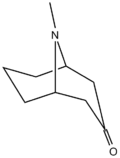Pseudopelletierine
 | |
| Names | |
|---|---|
| IUPAC name
9-Methyl-9-azabicyclo[3.3.1]nonan-3-one | |
| Other names
Pseudopunicine; Granatonine; Pseudopelletrierin; Granatan-3-one; Pseudopelletierin; psi-Pelletierine; 9-Methyl-3-granatanone | |
| Identifiers | |
| 552-70-5 | |
| 3D model (Jmol) | Interactive image |
| ChEBI | CHEBI:8607 |
| ECHA InfoCard | 100.008.202 |
| PubChem | 11096 |
| |
| Properties | |
| C9H15NO | |
| Molar mass | 153.23 g·mol−1 |
| Appearance | Colorless (yellows on exposure) |
| Melting point | 54 °C (129 °F; 327 K) |
| Boiling point | Sublimes at 40 °C (0.3 mmHg) |
| Except where otherwise noted, data are given for materials in their standard state (at 25 °C [77 °F], 100 kPa). | |
| | |
| Infobox references | |
Pseudopelletierine is the main alkaloid derived from the root-bark of the pomegranate tree (Punica granatum), along with at least three other alkaloids: pelletierine, isopelletierine, and methylpelleteirine (C9H17ON), which yield 1.8, 0.52, 0.01, and 0.20 grams per kilogram of raw bark. Isopelletierine is optically inactive.[1]
It is a homolog of tropinone, and can be synthesized in a manner analogous to the classical Robinson tropinone synthesis, using glutaraldehyde (rather than succinaldehyde), acetonedicarboxylic acid, and methylammonium chloride.[2]
Pelletierine sulphate is used medicinally in Iraq as an anthelmintic and anti-amoeboid. It triggers, like strychnine, a stimulant reflex, which is effective against tapeworms, ring worms and nematodes. Simple bark-extracts have recently been shown to be effective in vitro against the intestinal bacteria salmonella typhi, vibrio cholera, herpes simplex, HIV, and tumors.[3][4][5][6]
References
- ↑ http://library.sciencemadness.org/library/books/the_plant_alkaloids.pdf
- ↑ Pseudopelletierine, Organic Syntheses, Coll. Vol. 4, p.816 (1963); Vol. 37, p.73 (1957)
- ↑ Mavlyanov S. M., Islambekov S. Y., Karimdzhanov A. K. and Ismailov A. I. (1997), "Polyphenols of pomegranate peels show marked anti-tumor and anti-viral action", Chem. Nat. compounds Vol. 33, pp.98-99.
- ↑ Zhang J. (1995), "Antiviral activity of tannin from pericarp of Punica granatum against genital Herpes simplex virus in vitro",China Journal of Chinese Materia Medica, Vol. 20, pp.556-558.
- ↑ http://www.iasj.net/iasj?func=fulltext&aId=47308
- ↑ El-Sakka M. A. (2010)," phytochemistry alkaloids", 3rd edition